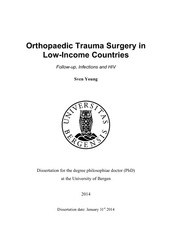| dc.contributor.author | Young, Sven | en_US |
| dc.date.accessioned | 2014-02-10T13:53:03Z | |
| dc.date.available | 2014-02-10T13:53:03Z | |
| dc.date.issued | 2014-01-31 | eng |
| dc.identifier.isbn | 978-82-308-2994-3 | en_US |
| dc.identifier.uri | https://hdl.handle.net/1956/7782 | |
| dc.description.abstract | This thesis is based on three published papers about complications after intramedullary (IM) nailing of fractures of the long bones in low- and middle-income countries (LMICs). The first two studies were register studies using data from the SIGN online surgical database (SOSD). The third study was a prospective study of patients treated for femoral fractures at Kamuzu Central Hospital in Malawi. The SOSD is, to my knowledge, currently the largest database in the world containing data on orthopaedic trauma surgery in LMICs. It was established to ease communication between SIGN Fracture Care International (SIGN) and surgeons using their IM nail. SIGN provides hospitals in LMICs with IM nails free of charge for the treatment of fractures in poor people. Being operated with an IM nail for a fracture of the thigh bone (femur) will have a patient out of bed in a few days, and this has been the obvious treatment of choice in high-income countries for more than half a century now. In many LMICs, however, femoral fractures are still treated with the patient in bed on traction for one and a half to three months. There are still many myths about the risks of doing surgery in LMICs. We wished to document the results and complications of IM nailing in LMICs so that better informed decisions can be made when planning surgical services in these countries. Lack of sufficient follow-up is a challenge in research in LMICs. We also wished to see how this influences results. We found that returning for follow-up in LIC can be difficult and very expensive for many patients. The motivation for returning for follow-up is therefore very low if a patient does not have any complaints. Insisting on very high follow-up rates in clinical research from low-income countries is unrealistic and can exclude important information from the literature. It does, however, seem as if people in low income countries mostly do return for follow-up if they have a complaint after surgery even if total follow up rates are low. This implies that results based only on the patients that returned for follow-up in LIC will be negatively biased. This should be kept in mind when interpreting results in research from LIC.Infection rates after IM nailing in LMIC are acceptable and infections, when they occur, usually manageable. The risk of infection should not be used as an argument against well-proven surgical treatment of fractures by properly trained surgeons in LMICs. Patients with femoral fractures in particular have a great deal to gain from IM nailing as opposed to spending months in hospital on skeletal traction. Patients registered in the SOSD undergoing IM nailing for a non-union had a more than doubled risk of postoperative infection. This further supports that, at least femoral fractures, should be treated early with IM nailing also in LMIC. Data from the SOSD suggests that there is a statistically increased risk of postoperative infection with decreasing income level of a country. However, infection rates are still low and this should not be used as an argument against the practice of orthopaedic trauma surgery in low-income countries. We found no statistically significant increase in infection rates when open reduction was used compared to closed reduction. The need for open reduction because of the lack of expensive equipment such as orthopaedic traction tables, C-arm image intensifiers etc. is no contraindication to the use of IM nailing in LMICs. People living with HIV do not seem to have a much increased risk of postoperative infection. This certainly is no argument against surgical treatment of fractures in HIV positive trauma patients. They might, however, have an increased postoperative mortality risk due to venous thromboembolism (VTE) after prolonged preoperative traction when low molecular weight heparin VTE prophylaxis is not available. This needs to be confirmed in larger studies, but in my opinion further strengthens the argument for the earliest possible IM nailing of femoral fractures in HIV positive trauma patients. | en_US |
| dc.language.iso | eng | eng |
| dc.publisher | The University of Bergen | eng |
| dc.relation.haspart | Paper I: Young S, Lie SA, Hallan G, Zirkle LG, Engesæter LB, Havelin LI. Low infection rates after 34,361 intramedullary nail operations in 55 low- and middle-income countries. Validation of the Surgical Implant Generation Network (SIGN) Online Surgical Database. Acta Orthopaedica 2011; 82 (6): 737-43. The article is also available at: <a href="http://hdl.handle.net/1956/7775" target="blank">http://hdl.handle.net/1956/7775</a> | en_US |
| dc.relation.haspart | Paper II: Young S, Lie SA, Hallan G, Zirkle LG, Engesæter LB, Havelin LI. Risk Factors for Infection after 46,113 Intramedullary Nail Operations in Low- and Middle-income Countries. World Journal of Surgery 2013; 37 (2): 349-55. The article is also available at: <a href="http://hdl.handle.net/1956/7778" target="blank">http://hdl.handle.net/1956/7778</a> | en_US |
| dc.relation.haspart | Paper III: Young S, Banza L, Hallan G, Beniyasi F, Manda K, Munthali B, Dybvik E, Engesæter LB, Havelin LI. Complications after trauma surgery in a low-income country. A prospective study of follow-up, HIV and infection rates after IM nailing of 141 femoral fractures at a central hospital in Malawi. Acta Orthopaedica 2013; 84 (5): 460-467. The article is also available at: <a href="http://hdl.handle.net/1956/7781" target="blank">http://hdl.handle.net/1956/7781</a> | en_US |
| dc.title | Orthopaedic Trauma Surgery in Low-Income Countries. Follow-up, Infections and HIV | en_US |
| dc.type | Doctoral thesis | |
| dc.rights.holder | Copyright the author. All rights reserved | |
